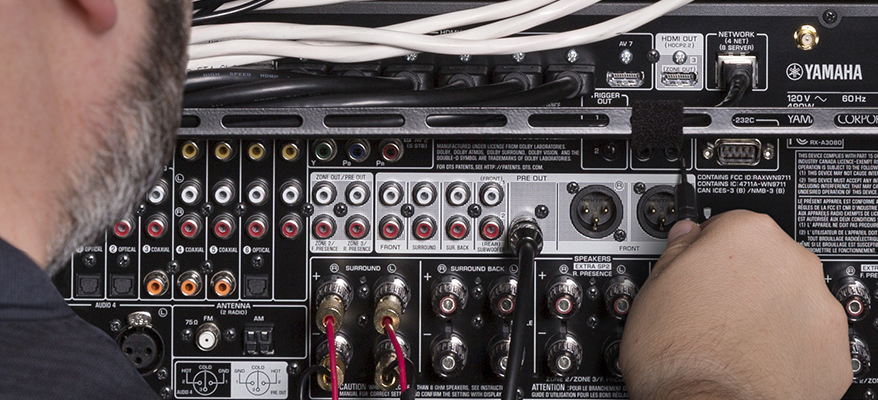The Smart Home Starts with Good Wi-Fi
How to stream your music without a hitch.
You wouldn’t dream of buying an automobile with a faulty engine. Nor would you spend your hard-earned dollars on a new refrigerator that keeps your food at a lukewarm temperature. You expect certain things to act a certain way, without fail, and everything else in your life to operate optimally.
The technology in your home should be no different. After all, there’s no reason for streaming music to not reach the speakers in your backyard, or for your internet connection to slow or come to a complete halt every now and then. And who wants to wait for the video on a big, beautiful display to buffer during the epic scene of a blockbuster movie?
Nonetheless, many homeowners just grin and bear it, throw up their hands, and chalk the matter up to the inherent trials and tribulations of owning smart home technology.
It doesn’t have to be like this.
Music can stream everywhere throughout the house without latency, which means that every speaker, no matter where it’s located, plays the song perfectly in sync — particularly important if you commonly stroll throughout your home when listening to music. You can be sure that every command sent to your whole-house system — whether by a mobile app, remote control, or voice-enabled device — reaches its destination fast and reliably. In fact, all your smart home devices can operate flawlessly. It all hinges on the quality of the Wi-Fi in your house.
The Importance of Speed and Bandwidth
Alas, Wi-Fi is far from perfect. For one thing, it comes in a variety of speeds, depending upon your internet service provider and the router you’re using. Needless to say, you should always opt for the fastest service and router you can afford, but any Wi-Fi network is only able to operate at full speed and full capacity if it has enough bandwidth. It’s like driving on a busy highway at rush hour. If you’re traveling on a single- or two-lane road, you can expect traffic jams and bottlenecks, but on a three- or four-lane road, you’re likely to move along at a much faster pace. In most households, there’s a lot of Wi-Fi activity going on 24/7. Anytime someone is surfing the internet, downloading videos or streaming music, bandwidth is consumed. When a lot of these activities are happening at the same time, the network can struggle to keep up.
So how do you preclude these issues? One twentieth-century solution would be to have everyone in your house — or all your equipment — take turns accessing the network. But that’s just silly in this day and age. Let’s take a look at some more modern approaches.
Repeat/Boost/Extend
Today’s typical router generally has more than enough reach to fill an apartment or small house with Wi-Fi, but it may not have the range to cover a larger home, which will result in dead spots cropping up. One of the easiest and most affordable ways to amp up your home’s Wi-Fi is by strategically placing one or more repeaters (sometimes known as boosters or extenders) around your home. These devices take the Wi-Fi signal coming from your existing router and rebroadcast it, effectively extending the overall range. This ensures that music streaming from a Yamaha MusicCast-enabled AV receiver or a MusicCast VINYL 500 wireless turntable, for example, will be able to reach those MusicCast speakers or sound bars located far away from your home’s router, all in perfect synchronicity and without dropouts.
Go Mesh
Even if you have excellent Wi-Fi coverage in your home, issues can still arise from the high amount of traffic on the network at the same time. That’s why you should consider installing a mesh network, which spreads your home’s Wi-Fi signal to multiple nodes positioned in various areas of the house instead of passing signals from point A (your router) to point B (the nearest access point). These nodes talk to each other to determine the quickest path for communications. In a smart home with a properly installed network, no matter how many people are simultaneously streaming data, video or music to and from various devices, nobody misses a beat.
Think Business, Not Residential
Today’s homes have networking requirements similar to that of businesses, so they are best served by the same type of enterprise-grade networking equipment that you might use at work, including the use of high-grade cabling capable of handling high-speed data transfer without dropout. This level of networking system is able to prioritize Wi-Fi traffic, which ensures that the songs streaming throughout your house won’t be interrupted when someone downloads a video. And as you add more smart devices, a high-quality networking system can be reconfigured with new prioritization parameters.
Hire a Professional
No matter how robust a networking system is, it’s only as good as the way in which it has been installed and configured. The best way to ensure that your Wi-Fi networking system has been installed correctly is to have a professional do the work. Yes, this will add to the cost, but what good is an investment in great equipment if it produces only mediocre results? A networking professional has the knowledge and tools to pinpoint possible Wi-Fi roadblocks in your home (concrete and metal are notorious for interfering with Wi-Fi signals), and to devise the appropriate solutions. Based on the layout and structure of your home and your networking needs, they can select the best equipment for the job, place networking devices where they will maintain the clearest, most reliable Wi-Fi connections, and configure the settings to best suit your household’s communications needs and entertainment enjoyment now and in the future — no matter how many new smart devices you add to your home.
Want to learn more? Check out these related blog articles:
Smart Home Integration — From DIY to CI Guy
The Perfect Pairing: Yamaha MusicCast and Home Automation
Get Your Party Started with the MusicCast VINYL 500
Click here for more information about Yamaha MusicCast.
Click here for more information about Yamaha MusicCast products.















